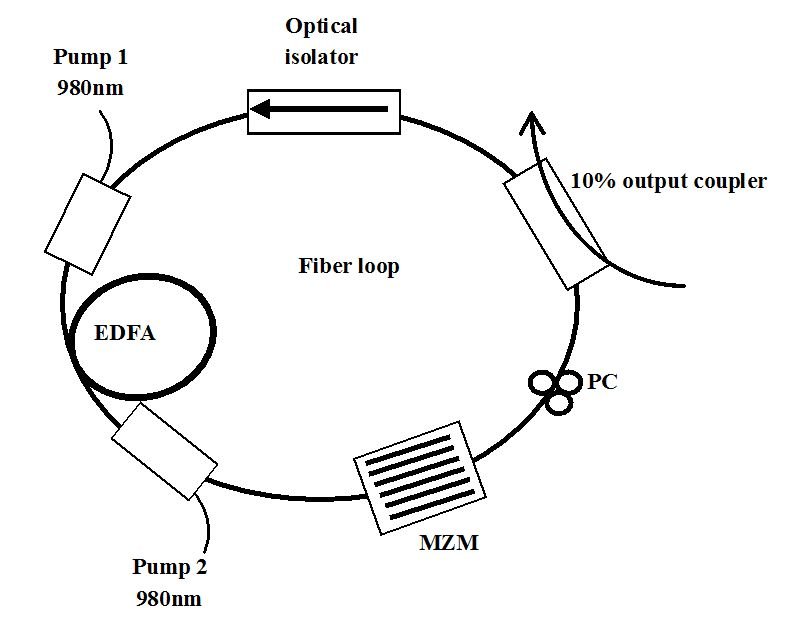Contents
- 1 Introduction:
- 2 Special Qualities of Fiber for Mode-Locked Lasers:
- 3 Limiting Factors and Challenges:
- 4 Operation Principles and Types:
- 5 Dispersion and Fiber Nonlinearity:
- 6 Amplification and Pulse Energy Enhancement:
- 7 Saturable Absorbers and Self-Starting Mode Locking:
- 8 Suppliers and Commercial Offerings:
- 9 Conclusions:
Introduction:
Fiber lasers have emerged as key players in the realm of ultrashort pulse generation, operating in the picosecond or femtosecond range through active or passive mode-locking techniques. This comprehensive exploration navigates through the special qualities, operational regimes, challenges, and amplification methods associated with mode-locked fiber lasers.
Special Qualities of Fiber for Mode-Locked Lasers:
Broad Gain Bandwidth and Efficiency:
Rare-earth-doped fibers boast a large gain bandwidth—typically in the tens of nanometers—enabling the generation of femtosecond pulses. The high gain efficiency of active fibers facilitates operation at low pump powers and tolerates intracavity optical elements with relatively high optical losses.
Cost-Effective and Compact Setups:
Mode-locked fiber laser setups can be fabricated at low cost, offering compact and rugged configurations. The compatibility of fiber lasers with telecom components, developed for long-term reliability, enhances their appeal for various applications.
Double-Clad Fibers:
The incorporation of double-clad fibers introduces the potential for high output powers, expanding the versatility of mode-locked fiber lasers.
Limiting Factors and Challenges:
Nonlinearities and Dispersion:
Despite their advantages, mode-locked fiber lasers face limitations imposed by the strong nonlinearities of fibers and chromatic dispersion. The nonlinear effects, coupled with dispersion, impact pulse energy, peak power, and overall pulse quality.
Challenges in High Repetition Rates:
Achieving very high pulse repetition rates in the multi-gigahertz range requires harmonic mode locking, introducing complexities that demand careful optimization for stability and reliability. Most femtosecond fiber lasers typically operate between 10 MHz and several hundred megahertz.
Uncontrolled Birefringence:
Difficulties arise from uncontrolled birefringence of fibers, particularly when polarization-maintaining fibers are not utilized. This can affect the stability and performance of mode-locked fiber lasers.
Operation Principles and Types:
1.5-μm Femtosecond Erbium Fiber Lasers:
Erbium-doped fibers, commonly used in amplifiers, exhibit a broad gain bandwidth, making them suitable for femtosecond pulse generation. Simple setups, such as those employing semiconductor saturable absorber mirrors (SESAMs), showcase the principles of operation.
Figure-Eight Fiber Lasers:
More sophisticated setups, like the figure-eight fiber laser, utilize a nonlinear amplifying loop mirror for mode-locking. This arrangement offers advantages in terms of stability and reliability, allowing for the generation of shorter pulses.
Ytterbium-based 1-μm Femtosecond Fiber Lasers:
Ytterbium-doped fiber lasers operate in the range of 1000–1100 nm, and their dispersion characteristics differ from erbium-doped lasers. Additional anomalous dispersion can be introduced using fiber Bragg gratings or photonic crystal fibers.
Dispersion and Fiber Nonlinearity:
Challenges in Fiber Lasers:
Compared to bulk lasers, fiber lasers experience stronger dispersive and nonlinear effects due to longer path lengths and small mode areas. Dispersion compensation techniques, such as chirped fiber Bragg gratings, are explored.
Soliton Mode-Locked Fiber Lasers:
Soliton mode locking, while conceptually simple, presents limitations in pulse energy and peak power due to strong nonlinear effects. Challenges include restrictions in achieving very short pulse durations and high average powers.
Amplification and Pulse Energy Enhancement:
Stretched-Pulse Fiber Lasers:
Stretched-pulse fiber lasers, also known as dispersion-managed fiber lasers, use alternating dispersion fiber spans to periodically stretch and compress pulses. This technique raises the pulse energy without excessive nonlinear phase shifts.
Parabolic Pulses in Similariton Fiber Lasers:
Similariton fiber lasers apply parabolic pulse amplification within a normal dispersion fiber laser resonator. The resulting chirped pulses can be compressively dispensed outside the laser resonator, achieving pulse durations below 100 fs.
Other Fiber Lasers in the Normal Dispersion Regime:
A broader class of all-normal-dispersion femtosecond fiber lasers is explored, where spectral filter action plays a crucial role in pulse formation. Special forms like the Mamyshev oscillator offer unique advantages.
Saturable Absorbers and Self-Starting Mode Locking:
Saturable Absorbers in Fiber Lasers:
Semiconductor saturable absorber mirrors (SESAMs) are employed for passive mode locking in fiber lasers. Challenges arise in adapting SESAMs for fiber lasers, with considerations like higher modulation depth and potential mechanical strain.
Self-Starting Challenges:
Ultrafast fiber lasers often face difficulties in self-starting mode locking. Parasitic reflections, fast saturable absorbers, and long resonator lengths contribute to the challenges, requiring innovative solutions for robust operation.
Suppliers and Commercial Offerings:
A snapshot of key suppliers in the mode-locked fiber laser domain showcases diverse products and features:
- MPB Communications: High-power mode-locked femtosecond fiber lasers operating in various spectral regions.
- TOPTICA Photonics: FemtoFiber lasers with polarization-maintaining fibers for applications like terahertz, microscopy, and attoscience.
- Vescent Photonics: MLL-100 generating sub-100 fs laser pulses with control inputs for cavity length and pump power.
- Thorlabs: A wide selection of ultrafast lasers covering applications from nonlinear excitation to THz generation.
- HÜBNER Photonics: VALO Series offering femtosecond pulses with very low noise and integrated dispersion pre-compensation.
Conclusions:
In conclusion, while fibers offer advantageous properties for short pulse generation, their dispersion and high nonlinearity pose challenges for mode-locked fiber lasers. The interplay of various mechanisms necessitates a deep understanding and innovative approaches for optimizing laser designs. Mode-locked fiber lasers, with their unique advantages and challenges, hold immense potential across scientific research and industrial applications, demanding continuous exploration and advancements.



